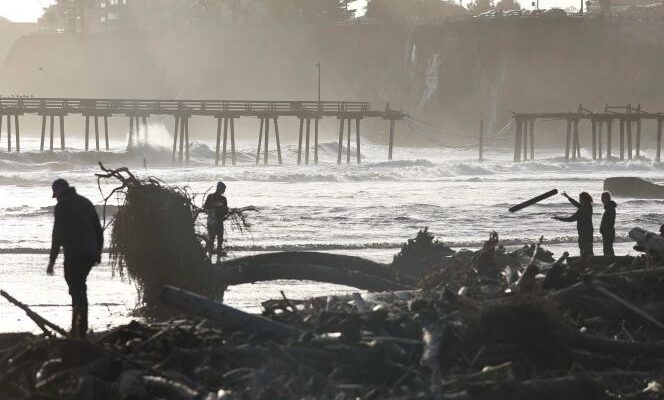LETTER FROM SAN FRANCISCO
The sun has returned, but where is the beach? At Ocean Beach, at the end of the earth, in the Land’s End district of San Francisco, the landscape is transfigured. Tons of sand were washed offshore by storms in early January. Debris of wood, whole trunks litter the coast. Walkers have made sculptures, bonfires, a “cemetery”, laments a local resident. A few kilometers to the south, at Fort Funston, a cliff from which hang gliders soar on windy days, a World War II bunker has rolled down the slope. Intact, it seems to be waiting for someone to help it back up…
Between late December 2022 and mid-January, San Francisco experienced an unprecedented amount of rainfall since 1871. Streets were flooded, sewers overflowed. According to experts, it is common for sand to be sucked offshore on high tide days. In 2021, the municipality also spent 2.8 million dollars (2.61 million euros) to bring it back to the shore. This time, the swelling of the Pacific moved it beyond the natural barrier that runs along the coast. The sand gone probably won’t come back.
A month after being hit by a succession of “atmospheric rivers” (corridors of water vapor causing intense rainfall), California is repairing, filling in, bailing out. The deluge claimed nineteen lives, more than the fires of the past two years combined, and more than $1 billion in damage. It caused 500 landslides, power cuts, many emergency evacuations.
A history marked by climatic extremes
Accustomed to never seeing a drop of water fall again, the inhabitants were taken aback. They had forgotten the other side of the climate in California, a jagged climate, made up of brutal droughts and torrential rainfall. Steinbeck already evoked this quasi-amnesia in the first chapter ofEast of Eden (1952), remind him Mercury News : “It was inevitable: during the dry years, people forgot the prosperous years and, as soon as the rains returned, they forgot the drought…”
Californian history is marked by climatic extremes. In 1862, the year of what remains known as “The Great Flood”, the Central Valley was covered for months by an inland sea. The governor and the assembly left Sacramento, the capital, to sit in San Francisco. In 1938, the floods caused a hundred deaths. More recently, the years 1982, 1986, 1995 have remained in the annals. “The difference is that at the time, the area only had farms, notes Matt Robinson, Sacramento County Water Spokesperson. Since then, we have built houses, dykes. The water circulation has been modified. People don’t realize they live in flood plains. »
You have 59.19% of this article left to read. The following is for subscribers only.
